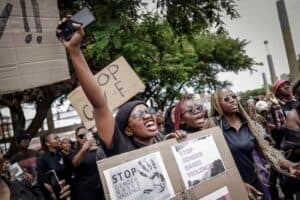Resilient. Pillar of society. Strong. “Bekezela”. We’ve all used them in different contexts, as a way to portray just how strong women are.

Resilient. Pillar of society. Strong. “Bekezela”. We’ve all used them in different contexts, as a way to portray just
how strong women are.
But are we speaking to the strength of women, or alluding to how strong women need to be in the face of adversity?
In the course of my job, I run focus groups and interviews with women from all walks of life and I’ve noticed a pattern emerging that ties in with my own experience as a young woman: what we call imbokodo – the need to be resilient in the face of societal norms, pressure and media that promote a depressive state in women.
Make no mistake, I am not disregarding the strength of women. What I’m getting at, is that we need to look deeper. When we call women resilient, are we, as a society and marketers, perpetuating a cycle of toxic positivity?
The Merriam-Webster dictionary defines resilience as “able to become strong, healthy, or successful again after something bad happens”.
ALSO READ: Battle against GBV hindered by lack of funds
A second definition describes a resilient material as “able to return to an original shape after being pulled, stretched, pressed, bent”. Is this starting to sound familiar? Calling women “resilient” is sticking a plaster over our
trauma.
In an unscientific survey conducted via WhatsApp status, I asked the women I know what resilience means to them. Let’s just say, they had nothing positive to say.
A response that stood out was, “resilience has been framed so negatively, I don’t know how it looks in a positive setting. It also has a hint of toxic positivity that romanticises suffering, where is the enjoyment?”
As a society and as marketers, we believe resilience is an empowering word – but if my little WhatsApp survey is any indication of the sentiment out there, perhaps we need to be having more actual conversations with women.
In the marketing world, it’s called “insights”.
It’s a buzzword we love to throw around the boardroom but are we putting it into practice? Why are we, as an industry, so comfortable with stereotypes and simple narratives? Could it be that we’ve become lazy?
The Dove “Courage is Beautiful” campaign is a great example of looking beyond stereotypes to find the real stories.
It was not about romanticising the work of doctors and nurses; rather, it highlighted their reality. It was an example of celebrating the spirit and not the body.
As strategists and creatives, we need to be courageous enough to develop solid content, based on the real-life experiences of women – who are the largest volume consumer in South Africa, incidentally.
ALSO READ: More efforts needed to fight gender-based violence
The narrative should be created by the qualitative insights we obtain around the actual lives of our target audience.
That means doing the research and doing it right.
What’s more, we need to be more responsible with how we use these insights – not only to create content, promotion and advertising, but to hold up helpful models, which are achievable and progressive and move everyone
forward.
Finally, let’s relook the language and tone we use. We should not be sticking a plaster on trauma with our communication.
Rather, we should be building a resonant voice for women’s lived experience through our brands.
- Mphaho is a strategist at brand customer experience agency VMLY&R.






